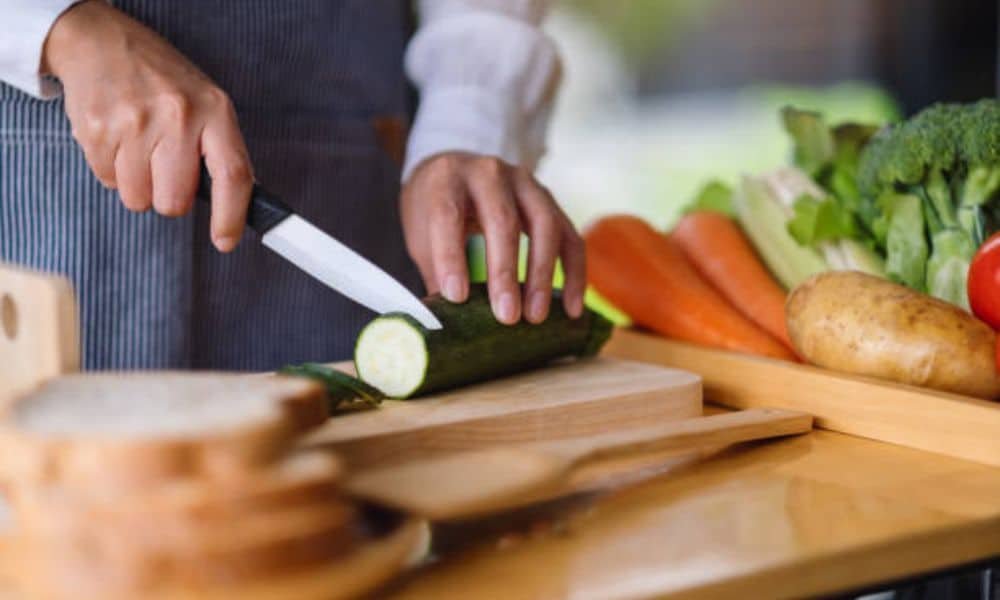I still remember the first time I felt grown up in the kitchen. It wasn’t baking. Wasn’t tea. It was holding a real chef’s knife. My grandmother smiled as she handed it to me. “Be careful. This one’s sharp,” she said. I was thirteen. Just cutting onions. But something clicked. That knife had weight. It felt strong. Not like the dull ones we had before. The slice was smooth. No mush. No tears. Just clean cuts. That moment sparked my love for cooking—and taught me respect for tools. Today, I’ll show you how to use kitchen knives properly, step by step.
Why Knowing Your Knife Matters
A knife is more than a tool. It’s an extension of your hand. A good knife helps you cook better, faster, and safer. A bad grip? That leads to slips. A wrong technique? That can mean uneven cuts, bruised herbs, or worse — a cut finger.
Knowing how to use kitchen knives properly isn’t about being fancy. It’s about feeling confident. It’s about joy in every slice. And yes, it all starts with the right tools—like a Best Kitchen Knife Set Under 100 that fits your hand and your budget. Let me show you everything I’ve learned.
Start with the Right Knife
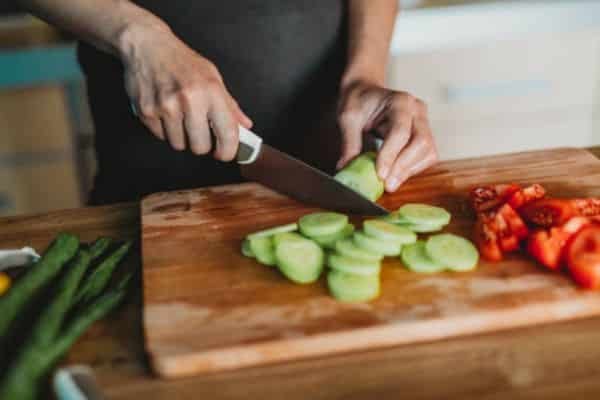
Before we talk about using, let’s talk about choosing one.
You don’t need a whole drawer full. You really only need three:
- Chefs – For most jobs. Think slicing meat, dicing onions, Chopping herbs.
- Paring – For small things like peeling, trimming, or segmenting fruit.
- Bread – For anything soft or crusty. Bread. Tomatoes. Even cake.
Hold the knife in your hand. It should feel balanced. Not too heavy. Not too light. You want control, not weightlifting.
The Proper Way to Hold a Knife
Holding the right way is the first step to better cooking. Most people just grab the handle and go. But that’s not safe — or smart.
Here’s how I do it:
- Grip the blade, not just the handle.
Pinch the base of the blade with your thumb and index finger. Wrap the rest of your fingers around the handle. This gives you control. Not just pressure. - Relax your grip.
Don’t choke it. Don’t hold it like a hammer. Think of holding a pen. Firm, but gentle. - Keep your wrist straight.
Let your arm do the work. Not your wrist.
This grip might feel odd at first. That’s okay. Give it time. It’ll become second nature.
Knife Safety Basics
Before you even slice that carrot, follow these safety habits. I swear by them.
- Always cut on a cutting board.
Not the countertop. Not your hand. Use a stable, clean board. - Keep the blade sharp.
A sharp knife is a safe knife. Dull ones slip. - Tuck your fingers in.
Use a claw grip on the hand holding the food. Fingers curled. Knuckles forward. Your knife should rest against your knuckles as you cut. That way, you won’t cut yourself. - Don’t rush.
Fast comes with practice. Focus on being steady first.
Step-by-Step: How to Use a Kitchen Knife Properly
Let’s go through the most common knife techniques. I’ve used these for years.
01. The Rock Chop (For Herbs and Veggies)
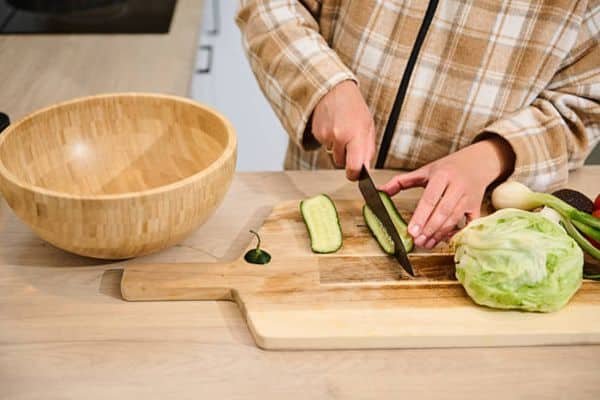
- Place the tip of your knife on the board.
- Keep it in contact.
- Rock the knife up and down, using the middle of the blade.
- Guide with your other hand.
This one’s great for parsley, onions, or even cabbage.
02. The Slice (For Meat or Fruit)
- Hold your knife at a slight angle.
- Use the whole length of the blade.
- Pull toward you, then push forward.
- Let the blade do the work.
Don’t saw. Don’t press hard. Just glide.
03. The Dice (For Even Cubes)
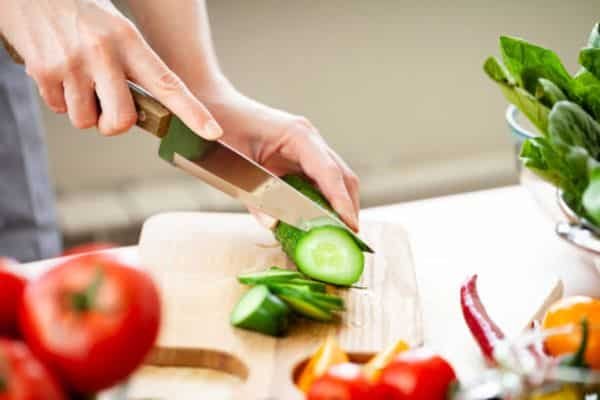
- Slice the ingredient into slabs.
- Stack them neatly.
- Slice into sticks.
- Rotate and cut across into cubes.
This works well for carrots, potatoes, or apples.
04. The Julienne (For Thin Strips)
- Slice your veggie into thin slabs.
- Stack those slabs.
- Cut into matchstick-sized strips.
Try this with peppers or zucchini. It looks fancy but is easy once you try.
Knife Maintenance
You don’t need to, baby, but you do need to respect it.
Here’s how I keep mine in top shape:
- Clean it right after use.
Warm water. Mild soap. Dry with a towel. Never soak it. Never put it in the dishwasher. - Store it safely.
Use a magnetic strip, knife block, or blade guard. Tossing it in a drawer will dull it, or cut your hand. - Sharpen it regularly.
Use a honing rod weekly to keep the edge straight. Use a whetstone every few months for a deeper sharpen. Or go to a pro. I do that twice a year.
What Not to Do With Your Knife
Some mistakes can ruin your dinner.
- Don’t cut bones or frozen food unless your knife is made for that.
- Don’t scrape food off the board with the blade’s edge. Flip it and use the spine.
- Don’t twist the knife mid-cut. That can chip the blade.
Treat well. It will return the favor.
Tips I’ve Learned the Hard Way
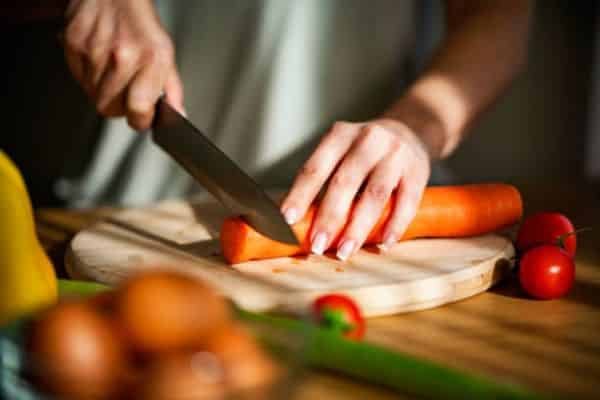
Let me share some small lessons that took me years to learn.
- Dry food is easier to cut.
Wet vegetables slip. Pat them dry first. - Use your body.
Stand close to the board. Let your shoulder, not just your hand, guide the motion. - Mind your angles.
Cutting straight down bruises food. A slight angle gives cleaner slices. - Practice with soft foods first.
Try cucumbers, zucchini, or boiled potatoes. Build skill before moving to harder stuff. - Don’t overthink it.
Knife skills get better with use. Cut every day. It adds up.
Cooking Becomes Joyful
Once become your friends, cooking feels different.
You move with ease. Your slices are clean. Your fingers stay safe. You start to enjoy the sound of the blade on the board. The way chopped herbs smell is stronger. The way carrots snap. You feel in control.
And that, to me, is the beauty of kitchen life. You don’t need a hundred gadgets. Just a knife. A board. And sometimes.
Final Thoughts
Using a kitchen knife properly isn’t about showing off. It’s about being connected. To your food. To yourself.
I’ve spent decades learning the feel of a good blade. And I still find joy in it every single day.
So next time you pick up a knife, pause for a second. Feel its balance. Respect its edge. Then slice with purpose. Because when you treat right, it teaches you something in return.

